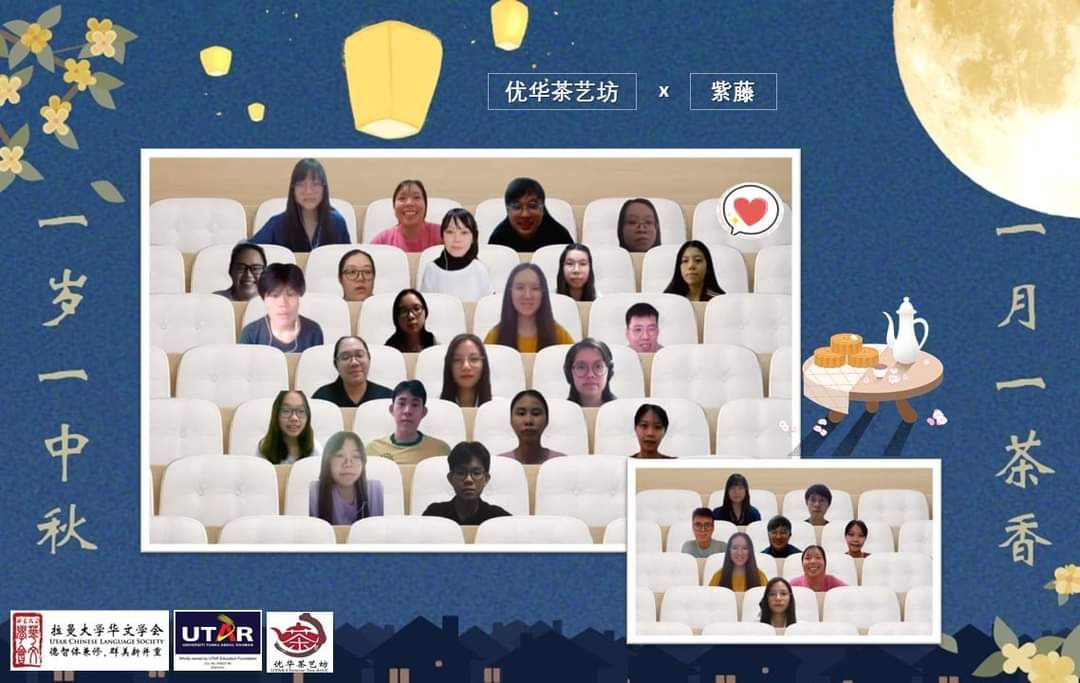
Promoting tea culture to the young

Wong (second row, third from left) and the participants
UTAR Chinese Language Society’s Chinese Tea Art and Cultural unit - UTAR Kampar Chinese Tea Art’C and Purple Cane (紫藤) co-organised a virtual sharing session on tea art titled “Autumn is here, Tea is here” (一岁一中秋,一月一茶香) on 4 September 2021 via Microsoft Team and Facebook Live.
Purple Cane Tea Art Learning Centre Person-in-charge-cum-Tea Artist Wong Sook Yee (黄淑仪茶艺师) was invited to conduct the talk. She joined the Purple Cane Group in 1994 and worked in the design and customer service department. In 2004, she became a tea art specialist at the Purple Cane Tea Art Learning Centre. Later, she began to serve as an instructor for tea art clubs in many Chinese independent schools in Malaysia. She has also served as a planner, host and tea maker for hundreds of tea banquets and tea parties.
The talk aimed to share knowledge regarding tea culture and promote it to UTAR staff and students, as well as the public. The talk was divided into two sessions; one session focused on young people’s view on teabags whereas the other focused on the link between the Mid-Autumn Festival, tea and mooncakes.
She began the talk by first sharing the brief history of the tea bag and how it was born. She revealed, “It was an unintentional work. The inventor of the first tea bag was an American tea importer called Thomas Sullivan. He shipped out his tea in silk bags, not expecting his customers to place the silk bags directly into the hot water. However, in the end, the ‘tea bag’ received a good response in the market. Hand sewn silk and cotton bags appeared in 1903, and in the following year, teabags gained commercial success. However, the heat-sealed paper fibre tea bag was only patented in 1930 by an American named William Hermanson. That design has continued to be used until now.”
She then introduced the types of teabags, which included triangle teabags, square teabags and round teabags, to name a few. She revealed, “Do not throw away the used teabags because they can be used to reduce eye bags; applied on the face for facer purpose; use as deodoriser and fertiliser, as well as paint material for re-creation.”
Wong introducing the uses of used teabags
Later on, she demonstrated the making of a few famous and easy-to-serve teas, namely sour plum white tea, lemon Pu’er honey tea and bubble fresh orange mixed fruit green tea. She said, “These teas can be served hot and cold, based on personal preference.” She also taught participants how to keep the teabags overnight so that they can continue to use them the next day.
The recipe for sour plum white tea, lemon Pu’er honey tea and bubble fresh orange mixed fruit green tea
In the second session, she shared the link between the Mid-Autumn Festival, tea and mooncake. She mentioned, “It is our culture to match mooncakes with tea during the Mid-Autumn Festival. Most importantly, teas can help to improve taste and reduce gastrointestinal burden after we eat the mooncakes. I would like to recommend, for mooncakes with a light taste and pure fillings like red bean, dates, white lotus and black sesame pastes, green tea, white tea and herbal flower tea are suitable. Meanwhile, mooncakes with complex and rich flavours like double yolk and assorted nuts, Oolong tea, Ripe Pu’er tea and black tea are suitable.”
Tea and mooncake are the perfect matches
During the Q&A session, the speaker discussed topics related to types of tea, tea making, the differences between hot and cold teas, ingredients to match with teas, and many more. The speaker provided the participants with a deeper understanding of tea and also parsed the myth of tea.
The virtual event ended with “Guess the Lantern Riddle” session, which aimed to provide a platform for participants to feel the joy of the Mid-Autumn Festival virtually. It received good responses from the participants.
© 2021 UNIVERSITI TUNKU ABDUL RAHMAN DU012(A).
Wholly owned by UTAR Education Foundation (200201010564(578227-M)) LEGAL STATEMENT TERM OF USAGE PRIVACY NOTICE